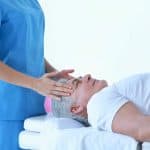 Want to earn continuing education credit for this article? Learn more.
Want to earn continuing education credit for this article? Learn more.
The use of surgical-type gloves by massage therapists is a fairly recent development. Though still a rarity, there are times gloves may be necessary to prevent the spread of infection.
A History of Rubber Gloves
The first person credited with using rubber gloves in a medical setting is William Stewart Halsted in 1894. He was the first surgeon in chief at Johns Hopkins Hospital. Those first gloves were more like rubber gloves used around the home today for cleaning, and a bit cumbersome. Disposable medical gloves made of latex rubber were not manufactured until 1964. Two years later they were the norm in most operating rooms in the United States.
It wasn’t until the mid-1980s, prompted by the AIDS epidemic, that the routine use of medical gloves spread to the examination room, as well as to any workers or aides who come in close contact with people in a healthcare setting or situation near possible contaminants. Anyone who had the potential for coming in contact with bodily fluids was advised to use universal precautions, as defined by the Centers for Disease Control and Prevention (CDC).
A rise in allergic reactions was noticed with the increased use of latex gloves, and there was a need to find alternatives. Although synthetic alternatives to rubber were developed in 1910, it wasn’t until fairly recently they were used in making medical-grade disposable gloves.
Latex Allergies
Latex is a natural product that comes from trees. After it is harvested it is mixed with chemicals to give it the properties of stretch and durability. When latex gloves were used primarily by surgeons and other operating room staff members, they were considered relatively safe. However, with increased use there was also a marked increase in allergic reactions by both healthcare workers and patients. It is estimated that up to 17 percent of healthcare workers have developed latex allergies since the inception of higher standard of universal precautions.
There are three major forms of negative physiological reactions to latex:
- Irritant Dermatitis – This is a reaction not caused by the body’s immune system and is not an allergic response. It can be caused by frequent hand washing and inadequate drying, as well as the abrasive effect of the powders used in some gloves. It can also be caused by a surrounding climate (too hot, cold or dry air) that contributes to chapped skin. Skin that is compromised can allow latex proteins to pass into the body and result in the acquisition of a latex allergy.
- Type IV Allergy – This is also referred to as delayed cutaneous hypersensitivity and is usually the result of a reaction to the chemicals used to produce latex. It affects the area of skin that has come in contact with the glove and may take up to 48 hours to develop. Having this type of reaction increases the risk of an individual in developing a type I allergy.
- Type I Allergy – This reaction is almost immediate (within 30 minutes) and is caused by a systemic response to the proteins found in natural latex. In milder cases there could be hives, rhinitis, conjunctivitis and/or bronchoconstriction. In more severe cases there could be anaphylaxis and hypotension (a drop in blood pressure). This type of reaction can be caused not only by the wearing of the latex glove, but also by the inhalation of glove powder, which binds to and acts as a carrier for the latex proteins.
Aside from allergies, a problem somewhat specific to massage therapists is the use of massage oil or other non water-based lubricants when wearing the latex gloves. If the gloves are exposed to these products for any length of time (more than 15 minutes), the material is subject to deterioration. Put simply, the latex begins to bind to the oil and melt. This can lead to a breakdown in the barrier between the hands of the massage therapist and the client.
Alternatives to Latex
With the apparent increase in allergic reactions to latex, there has been an increased development and use of alternatives, such as vinyl and nitrile, each with their own benefits and drawbacks. It is generally agreed that latex gives the best fit and greatest sense of feel to the practitioner. It is also the most durable of the glove materials. Nitrile comes in at a close second with good flexibility and a high resistance to oils and solvents. Vinyl, while not allergenic, fits poorly, tears easily and also deteriorates when exposed to non water-based lubricants. Many institutions, including Johns Hopkins, are now opting for a latex free environment and switching to synthetics, such as nitrile for gloves and other items.
Proper Glove Use for Massage Therapists
Medical-grade gloves are used to protect both the healthcare worker and the person being examined, operated on or receiving a massage. It is important to be aware of their care and use.
- Universal precautions dictate the use of a glove barrier when a healthcare worker may be exposed to certain bodily fluids, including blood. This includes not only the client who may have cuts, abrasions or other broken skin, but also the massage therapist with a cut finger or hand (finger cots can be used on individual fingers if the cut is small). Gloves should also be used inside the mouth during massage for temporomandibular joint problems and in certain cases when a client has undergone chemotherapy treatments.
- Avoid the use of latex gloves if at all possible and use synthetics, such as nitrile. If the massage therapist is not allergic, the client may be.
- If latex gloves are used, use a non oil-based lubricant (water or glycerine based are alternatives) on the client and do not use any oil-based hand creams or alcohol based sanitizers while working.
- Choose glove size that fits snugly (but not too tight) and has a comfortable contour and thumb position.
- Wash, rinse and dry hands thoroughly before and after using gloves.
- Don’t wear gloves for more than an hour at a time.
- Never wash and reuse disposable gloves. Doing so may result in micro-tears in the material and compromises the barrier.
- Learn how to put on and take off gloves properly, so as not to spread possible contaminants or allergens.
Bodyworkers rarely find the need to don gloves when working on clients, but with the increase in hospital-based, or medical massage, use is on the rise. Make sure you are aware of your options and select what is the safest and most comfortable for you and your client.
Earn continuing education credit for this article contained in our Infection Control – Bacteria series. Click here to enroll.















